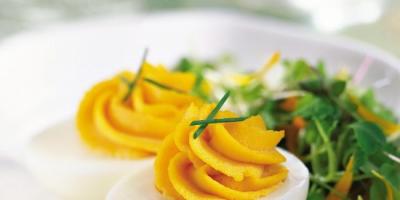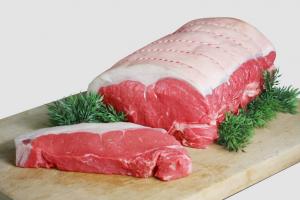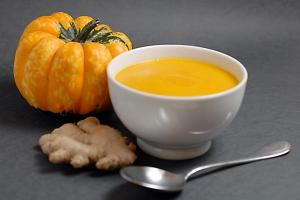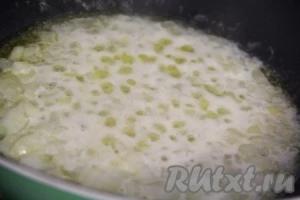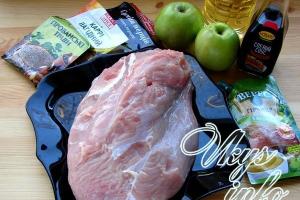A loaf of white bread (depending on the type and weight) in the USSR cost from 13 to 25 kopecks. A loaf of black bread, respectively, from 16 to 18 kopecks. A kilogram of the first grade in state stores could cost 1 ruble 60 kopecks, and a kilogram of the second grade (with bones) for 1 ruble 40 kopecks. The same meat in cooperative stores or markets was more expensive - 2 rubles 90 kopecks per kilogram. Pork in state stores was sold at a price of 1 ruble 80 kopecks, and in cooperatives and markets its price reached 3 rubles 50 kopecks.
However, it was not always possible to buy meat in state stores. In many regions of the USSR there was a persistent shortage of this food product.
Boiled sausages of the most common varieties, which were mainly found on sale, “Doctorskaya” and “Lyubitelskaya” cost, respectively, 2 rubles 20 kopecks and 3 rubles 20 kopecks per kilogram. Ham, if it was found on the shelves of state stores, could be purchased at a price of 3 rubles 50 kopecks per kilogram.
It should be noted that at that time, sausages and ham were produced in strict accordance with GOST standards and contained exclusively high-quality natural ingredients.
A liter of milk cost an average of 40 kopecks, a kilogram pack - 1 ruble 60 kopecks, and a kilogram granulated sugar– 90 kopecks. A 3-kilogram bag of potatoes could be bought for 33 kopecks.
At what price were non-essential products sold?
Almost all segments of the population, even low-income ones, had access to not only basic food, but also all kinds of delicacies. The cheapest (but very tasty and high-quality) berry-based ice cream cost 7 kopecks per serving. A briquette of “Ice cream” cost from 13 to 20 kopecks. Various pies, buns, and cakes could be purchased at prices ranging from 6 to 22 kopecks per piece.
A very popular product in the USSR, vodka was sold at prices ranging from 3 rubles 62 kopecks to 4 rubles 12 kopecks for a 0.5 liter bottle. And in the summer heat, you could quench your thirst with a glass of draft kvass for 3 kopecks or a carbonated drink with syrup from a street machine for the same price. The same machine could dispense a portion of just sparkling water, that is, without syrup, for just 1 kopeck. There was not the abundance of goods on sale that can be found today, but people could do without them.
October 20th, 2017The card system in force during the war was abolished in 1947, the government carried out monetary reform, and the USSR economy began to gradually recover. The products were mostly domestically produced. At the beginning of 1949, the Council for Mutual Economic Assistance was created, which included all countries of the socialist bloc, including the GDR. Imports of various products into the USSR began from the CMEA member countries, including food products...
Finland was the first country outside the Council for Mutual Economic Assistance to begin supplying its food products to the USSR. In 1956, the Valio concern began supplying Viola cheese to the Soviet Union - even then a blonde was depicted on the small round jar, which can be seen on the packaging to this day.
After the cheese was eaten, the jars were not thrown away, but were used to store various small items - the packaging was very outlandish.
Now the Valio company is under sanctions, but the cheese can still be seen on the shelves - only the production line in Finland itself, which worked for the Russian market, has been stopped.
The company's products produced at a plant in Russia are not subject to sanctions (the same applies to all other foreign manufacturers who have their production in our country).
Help from social bloc countries
In the 70s, the USSR had a fairly large assortment of products from abroad (mainly, naturally, from the countries of the social bloc). Frozen vegetables and fruits from the Polish company Hortex were sold - all of Moscow came to buy them at the company store near the Akademicheskaya metro station.
Canned vegetables produced by the Bulgarkonserv company were imported from Bulgaria: eggplant caviar, beans in tomato, even cabbage rolls. Sometimes you could find Bulgarian Turkish delight on the shelves.
Both companies - Hortex and Bulgarkonserv - exist to this day. Hortex fell under sanctions, Bulgarkonserv continues to supply products to Russia - the embargo does not apply to conservation, which the company specializes in.
Canned food was also imported from Hungary to the Union, and corn in cans from Romania. Wines were also imported from that region to the USSR - Yugoslav or Hungarian, which were considered a scarce product and made a splash at any feast.
Among the imported canned goods there was the popular Hungarian green peas from Globus. These canned foods were the standard of taste and quality, and some considered Hungarian peas much tastier than fresh ones from the garden.
Sausages with green peas were served in almost every Soviet canteen, but getting imported peas was a special, incomparable success.
Now Globus brand canned food can be found on store shelves. The company's head office is located in Budapest, but there is a manufacturing plant in Kuban in Russia.
It is worth mentioning sausage separately - it was a kind of symbol of prosperity and economic stability, a symbol of the flourishing well-being of the country of workers and peasants.
In the late 50s, sausage in the USSR became one of the main components of the meat diet: stores had many varieties of inexpensive Soviet sausages.
But in the early 70s, when problems began in the meat industry, traditional recipes sausages began to change towards combined meat products. During production, more starch, flour and other non-meat ingredients began to be added to the sausage.
Then cervelat from Hungary began to be supplied to the USSR, but it only went to officials and especially valuable employees of enterprises. Hungarian servelat was given “to order”; it appeared very rarely in regular stores.
Banana Republics
In the mid-1950s, bananas began to be imported to the USSR from friendly African and Asian countries. The main suppliers at first were Vietnam and China - the leaders Mao Zedong and Ho Chi Minh paid for food supplies, including military loans issued to them by the Union.
Due to transportation problems, bananas were delivered in good condition only to the eastern part of the USSR, and in Moscow and Leningrad they could be found quite rarely and on occasion.
After the outbreak of the Vietnam War and the Sino-Soviet conflict in the late 60s, bananas began to be supplied not from Asia, but from friendly Caribbean countries, in particular from Cuba and Ecuador. There were queues for them, although the price for the exotic was quite frightening - 2 rubles per kilogram.
To prevent the strange fruits from rotting, they were brought into the country while still green: Soviet citizens wrapped the bananas in newspaper and put them in a dark, dry place to “ripen.”
Purchases from the USA
In the early 60s, due to the ineffectiveness of virgin land development and a number of other economic factors, the USSR was forced to turn to the West for help. In 1963, wheat supplies began from the United States to the Union. Grain was also purchased from Australia, Canada and France.
Sugar and soybeans were also purchased abroad. In the mid-70s, due to problems with the livestock industry, beef began to be imported for the Soviet meat processing industry. The import of foreign meat was gaining momentum, and poultry products - frozen chickens and chickens - were added to beef.
In 1990, in the last year of the existence of the USSR, Mikhail Gorbachev signed an agreement with George Bush Sr. on the supply of frozen chicken legs to the country - those famous “Bush legs”.
There were a lot of horror stories about them - in particular, it was believed that American hams were very harmful to health and were stuffed with antibiotics and hormonal drugs.
Various jokes and anecdotes about “Bush's legs” were incredibly popular, and the phrase became a catchphrase. Now, due to sanctions, the import of meat products from the United States, including chicken legs, is completely prohibited.
The era of "Birch"
One of the main sources of scarce foreign goods was the Beryozka store - the first stores of this retail chain were created in 1961.
At first, “Beryozki” was only in Vnukovo and Sheremetyevo, then two stores opened in the capital’s hotels “Ukraine” and “Leningradskaya”; later “Beryozki” appeared in Leningrad and the capitals of the union republics.
Beryozka store, Sheremetyevo airport. Moscow 1986
At first the shops sold Soviet goods high quality - they were sold to foreigners for the currency that the USSR always needed. Fur coats, caviar, vodka and small souvenirs like nesting dolls or Dymkovo toys were in demand among visitors.
Prices for goods were much higher than in ordinary Soviet stores, but the country was in dire need of foreign currency.
Soviet citizens also visited Beryozka, who went on business trips abroad and brought currency from there. Since the mid-60s, trade with compatriots was carried out by bank transfer: foreign currency was transferred to an account at Vnesheconombank and then exchanged for special certificates (later checks), which were used to pay at Beryozka.
The prices in the price list were also displayed on receipts. These checks were the subject of major speculation on the black market until the late 1980s.
Later, imported goods appeared in Beryozka, which an ordinary Soviet person did not even dare to dream about. This is what was written in the “Price List for Food Products” of one of the stores:
“...There is a wide selection of Soviet and imported goods: Russian vodka and liqueurs, Scotch whiskey, English gins, French cognacs (...).”
At the entrance to the store of scarce imported goods there was often a guard who asked to present receipts - so that ordinary Soviet citizens would not go to Beryozka as if it were a museum.
This privileged supply channel, which supplied foreign food products along with Japanese equipment and French coats, was often used by Soviet officials.
Since 1992, Beryozka again began accepting cash foreign currency instead of Soviet checks, and by the mid-90s it closed because it became unprofitable.
There is a “Book about tasty and healthy food” on the kitchen table. It gives a complete picture of what the Soviet person's consumer basket contained. In 1973, when, according to the beautiful announcers of Soviet television, everything that was planned to be accomplished was exceeded - the bins of the homeland were bursting - the Soviet people had everything they needed. “And be sure to bring meat so that there is something to feed you...” - From a letter from my grandmother from Crimea to Moscow before our annual summer visit. There was no meat in the store - that's true. But even then, dairy products were tastier in Crimea than in Moscow. There was always fresh food in the refrigerator of a Soviet person, because the Soviet worker ate every day, after hours of hard work. Going to the store with a string bag, he could always choose between four or five types of white bread. And also bagels and bagels, the taste of which, by the way, can never be tasted anywhere else. No delicious bread on the shelves. And black fresh bread from rye flour- filled the entire bakery with its smell. Sausage at 2.20 and 2.80 - boiled - with or without fat. Butter by weight - hung on a piece of craft paper - highest grade and “Vologda” - special. Sausages. The chicken is still wrapped in kraft paper, with its uncut head sticking out. The taste of the healing broth of the USSR from chicken - the current one can no longer be achieved, even by draining the water several times - it smells of fish, but not poultry. In the sausage department of a Soviet store, when there was something, it smelled delicious. Krakow sausage - with garlic, liver sausage - in natural blue. At the grocery store, potatoes were being dumped out of a device that looked like a garbage chute. And yet, despite the lumps of dirt and rot, it was tasty. Today we went around several markets and shops to buy a child a potato that looks like a potato, one that sprouts as it should and spoils because it is not pumped with all sorts of chemical sludge. Somehow a beautiful tomato stayed in my refrigerator for 4 months. After 2, I washed it thoroughly and pierced it. But it did not spoil... Food products in the USSR were very good quality. Several generations of healthy Russian people grew up on them, the simplest ones - cabbage, beets, cucumbers, borscht and stew. No one even thought about any transgenic gastronomic chaos. And now, buying quality meat, butter, milk reminds me of hunting. Basically, all stores in the USSR had counters. The lack of product range was masked by slides and pyramids of canned goods. Pyramids of sprat in tomato, stewed meat, condensed milk, oh, what condensed milk there was. Sunflower oil was poured into bottles from devices resembling “lagidze waters.” Only in the mid-70s did supermarkets appear - similar to supermarkets. Many products were in short supply in the USSR, but living in Moscow, we suffered less from their shortage. I cannot say that my relatives suffered in Ukraine and Moldova while conscientiously conducting subsistence farming. On the contrary, they treated us to amazingly delicious gifts. Each republic of the USSR had its own gastronomic devices. My father traveled around the Union a lot. I brought caviar from Astrakhan and it’s unthinkable delicious fish. Cognac from Moldova - in cans. From Georgia Suluguni and Khvanchkaru. In winter, there was a melon from Tashkent on the table - ripe and red. For some reason, only in Italy did I manage to remember its taste. Maybe not everything was on the table of the Soviet people, but what was there not only satisfied hunger, but also left a pleasant aftertaste and did not raise doubts about its naturalness.
Victoria Maltseva
Schools in the USSR were very different from modern ones. And the Soviet school had one peculiarity. Common school uniform for the whole country. The most interesting thing is that the uniform of those times is still popular among graduates - a school dress with a white apron, usually white knee socks and the obligatory white bows. On ordinary days, girls went to school in dark aprons. The boys had an emblem on the sleeves of their jackets, which depicted an open book and the sun. At that time, everyone was either an October warrior, or a pioneer, or a Komsomol member, and they always wore a corresponding badge on the lapel of their jacket or dress. In the 1st grade, all schoolchildren were accepted into the October class. In the 3rd - to the pioneers. Moreover, first of all, excellent students, and secondly and even thirdly - those whose academic performance or discipline were lame. I was accepted into the Komsomol in the 7th grade.
In the 80s, every more or less large enterprise had its own pioneer camp, where they sent the children of their employees. The vast majority of Soviet children have visited a country pioneer camp at least once. In addition, in all cities, as a rule, at schools, “urban” camps were created with daytime stay for children. Each country pioneer camp operated in three shifts, each lasting approximately three weeks. All children in the pioneer camp were divided into groups according to age. The 1st detachment was the oldest. Then 2nd, 3rd, etc. Various children's amateur groups based on their interests worked in the pioneer camps, and the military sports game “Zarnitsa” was held. During the shift, various games, hikes, competitions were held in the camp... At the end of each summer shift, a “Farewell Bonfire” was organized.

The selection of products in grocery and department store stores in the 80s was far from amazing in its variety. Residents of all nearby cities went to Moscow to buy food. At this time, in 1985, a new scourge fell on the heads of Soviet citizens: the anti-alcohol campaign. All over the country, all alcohol disappeared from store shelves, restaurants and cafes. Of course, Soviet holidays did not become alcohol-free. People switched to moonshine, cologne, medical alcohol and other home-made booze.
In the Soviet assortment there was a clear shortage of products that could simply be pulled out of the refrigerator and eaten - sausages, cheeses, pates, not to mention some caviar or ham. Even sprats were a delicacy that was given in sets for the holiday. And only in Moscow, after standing in a long line, it was possible to buy sausages, salami or ham and not worry about tea and sandwiches for several days... In provincial cities it was practically impossible to get them. And this despite the fact that in many cities meat processing plants were operating at full capacity!
They brought good ones from Moscow chocolates- “Squirrel”, “Teddy Bear”, “Little Red Riding Hood”. They brought instant coffee, oranges, lemons and even bananas. Moscow seemed like a fabulous place where extraordinary people live. We also went to Moscow to buy clothes and shoes. In Moscow they bought everything, from buckwheat to children's tights, because... all this was in short supply in the middle zone.

Grocery stores of that time had several departments. Each department sold its own product groups. It was worse if the department sold goods by weight. First, you had to stand in line to weigh the goods, then line up at the cash register, get a receipt, and then line up again at the department. There were also self-service supermarkets - like today's ones. There, goods were paid for at the checkout when leaving the hall. At that time, every schoolchild went to buy milk. Due to the paucity of product range in stores at that time, milk and dairy products occupied a fairly significant place in the diet of Soviet people. Porridge was cooked in milk. Noodles and horns were cooked with milk. In the USSR, dairy products were packaged in glass containers, which were washed and handed over at special collection points for glass containers. As a rule, they were right next to the stores. There were no labels on the bottles. The label was on the lid. Milk bottles were closed with caps made of soft foil of different colors. The name of the product, date of manufacture, and cost were written on the lid.


Sour cream was sold on tap from large metal cans. There were several types of butter - butter and sandwich. Loose butter cost 3 rubles 40 kopecks per kilogram, and a pack butter- 72 kopecks. Milk in the Soviet Union was made from milk! There was sour cream in the sour cream, kefir in the kefir, and butter in the butter. At lunchtime, as a rule, fresh milk, bread and some other products were brought to each grocery store. Therefore, when the store opened after the lunch break, it was often possible to buy everything specified by the parents. You could also buy ice cream!

The iconic dairy product in the USSR was condensed milk. Favorite treat children. Condensed milk produced in the USSR was packaged in tin tin cans with white and blue labels. They drank it straight from the can, punching two holes with a can opener. It was added to coffee. It was boiled directly in a closed jar to be eaten boiled or used for cake. During the time of food shortages at the end of the USSR, condensed milk, along with stewed meat, was included in holiday food packages distributed according to coupons and lists in individual organizations, as well as to certain categories of citizens who had benefits by law (participants and disabled people of the Great Patriotic War, etc.).


It was difficult to buy a good outfit, so we looked for decent fabric in advance and went to an atelier or to a familiar dressmaker. If a man, in preparation for the holiday, only had to exchange his home workouts for a shirt, and, perhaps, as a sign of special affection, shave, then it was much more difficult for a woman. And she could only rely on her own ingenuity and skillful hands. They used: henna, hydrogen peroxide, curlers. “Leningrad” mascara was mixed with flour and applied to the eyelashes. Using various household dyes, flesh-colored nylon tights were dyed black. The height of fragrant chic was the Klima perfume, the bottom limit was the Perhaps perfume. A man was supposed to smell too, but the choice was even smaller: “Sasha”, “Russian Forest”, “Triple”.

There was very little cosmetics in the USSR, and if there was, they didn’t buy it, but “got it out.” Mascara was produced in pressed form and had to be diluted with water before use. However, water was not always at hand, so Soviet fashionistas simply spat into a box of mascara. The most desperate ones separated their eyelashes with needles or pins. Women in the 80s had a practice of using cosmetic products “inappropriately.” Many women had already figured out the current fashionable technique among makeup artists - using lipstick as blush. An even complexion was ensured by the legendary cosmetic product of those years - the Ballet foundation from the Svoboda factory. Instead of colorless lipstick, Vaseline was usually used, and instead of hand cream, glycerin was used, which could almost always be bought at the pharmacy.

The object of particular desire was the Este Lauder Blush from the company store, which could only be accessed by special invitation. All women of that time dreamed of Lancôme “golden roses” and Dior powders and lipsticks packaged in blue boxes. If you ask ladies whose youth occurred during these years, they will remember the perfume “Climat” and the legendary fragrance “Magie Noire” from Lancôme, as well as “Opium” from YSL and “Fidji” from Guy Laroche. Most Soviet women knew about the famous “Chanel No. 5” only by hearsay, and a very small number of ladies used them in real life.
Traditional dishes in holidays there were salads Olivier, Herring under a fur coat, Mimosa, fried homemade cutlets, made sandwiches with sprats, cooked jellied meat, baked chicken, took out homemade marinades. One of the most important dishes on the festive table was cake, which was very difficult to buy. Most often they baked homemade Napoleon. The drinks were not particularly varied: “Soviet champagne”, “Stolichnaya” vodka, “Buratino” lemonade, fruit juice and compote. In the late 80s, Pepsi-Cola and Fanta began to appear on tables. Festive table They always cooked thoroughly, even if no guests were expected, and the celebration took place in the family circle!


On New Year A Christmas tree was installed in every house. A garland of multi-colored lights was arranged on the tree and Christmas decorations were hung - glass shiny balls of different colors, satellites, icicles, bears and bunnies made of cardboard, covered with varnish and glitter, snowflakes, beads and crackers. Below, under the tree, Santa Claus made of papier-mâché was installed on pre-laid gauze or cotton wool! A star was placed on the top of the tree.
The choice of gifts for the holidays was very limited. In the absence of normal gifts, when going on a visit, they carried with them the delicacies that they could get, jars of canned exotic fruits, black or red caviar, chocolates. You could buy a book, a bottle of perfume, an electric razor, etc. Children's New Year's gifts, parents brought home from work. The trade union committee consistently provided parents with children's gifts - one for each child under 14 years of age. For holiday parties, firecrackers and sparklers were purchased - at that time this was the only “pyrotechnics” with the help of which they kept the fun going. Only rocket launchers, which not everyone had, could add variety to such fun.
Almost every New Year, films were shown on television: “An Ordinary Miracle” and “Sorcerers.” The main New Year's film is “The Irony of Fate or Enjoy Your Bath.” Many already knew these films by heart, but nevertheless enjoyed watching them again. IN New Year's Eve Everyone traditionally gathered around a festively laid table, said goodbye to the old year and welcomed the new one. We watched TV, listened to music. And in the morning, after the “Blue Light,” “Melodies and Rhythms of Foreign Pop” was shown on TV for the only time a year! Boney M, Abba, Smokie, Africe Simone.…


In the 80s there was no entertainment other than the cinema, bar or dancing. Bars and cafes were not open at night. Soviet or Indian films were shown in cinemas. The main activity for young people, besides drinking port wine at the entrance, studying well and joining the Komsomol, was dancing, and they called it a disco. The music at the discos was collected from everything that came to us “from there” mixed with the best that we had. Alla Pugacheva tried to stand out from the crowd with her airy, vast robes, and Valery Leontyev scared elderly grandmothers with his terribly tight trousers. The discos featured: Forum, Mirage, KarMan, Laskovyi Mai, Na-Na and a performer parodying Western musical performers, Sergei Minaev. In addition to dance groups, the groups “Sunday” and “Time Machine” were popular. Hits of famous foreign musical groups and performers were heard more and more often: Modern Talking, Madonna, Michael Jackson, Scorpions and others.
How old were you in the 80s? 10? 15? 20? Do you remember the atmosphere of general goodwill and mutual respect that reigned in Soviet times? Inner peace, awareness of life goals and ways to achieve them. Confidence in everything for decades to come. An opportunity to take a worthy place in life. Do you remember how in May everyone went to demonstrations? Everyone took to the streets with balloons and flags, congratulated each other and shouted “HURRAY!” And the children were placed on the shoulders. Rubber bands in the yard.... Collecting scrap metal and waste paper at school.... Community work days.... Subscription to the magazines "Funny Pictures", "Pioneer", "Crocodile", "Science and Life".... Do you remember school “dance evenings”, discos in pioneer camps, in cultural centers? Songs that were carefully copied from cassette to cassette and listened to “to the holes.” Songs that we went to listen to at each other’s houses...

In general, music in the USSR was considered something unnecessary for the daily life of a citizen, a kind of acceptable surplus (except, of course, for songs performed by a choir - at a pioneer line, in military formation, etc.). Therefore, devices for playing and recording music were treated more like things closer to luxury items than everyday items. Most houses had record players. Musical recordings in the USSR were sold on Melodiya records. Records with fairy tales for children were also produced. Entire generations grew up in the USSR listening to fairy tales recorded on records. It was quite difficult to “get” records with recordings of popular pop performers at that time.
In the eighties, most residents of the USSR acquired tape recorders. There were queues for especially fashionable ones, like Vega and Radiotekhnika. Domestic reel-to-reel film and cassettes were also everywhere. The tape recorders were extremely expensive. By the mid-80s, the USSR had learned to produce pretty good reel-to-reel tape recorders. They didn't break down often and didn't produce the worst sound. However, who in those years wanted a reel-to-reel tape recorder? They were bulky, non-transportable, and even the process of loading the film itself required a certain skill. But most importantly, by that time reels were already rapidly being replaced by cassettes. Soon, among youth and teenagers, the reel-to-reel tape recorder was considered a hopeless archaism.

Soviet tape recorders, accessible to most, like Soviet cassettes, were simply terrible. The film in Soviet cassettes was comparable to a tape recorder. It could provide only very modest recording quality, and if you tried to re-record frequently, it quickly broke down. But tape recorders really liked this film! They chewed it with great pleasure at every opportunity. This case was shrewdly provided for by cassette manufacturers, and therefore there were often no screws on their casing.
The height of desire for music lovers, of course, were Japanese tape recorders - Sharp, Sony, Panasonic. They stood proudly on the shelves of thrift stores, flaunting breathtaking price tags. Imported goods (in small quantities entering the USSR market) were perceived by the population as “prestigious” and of high quality. There were virtually no cheap imports, including “Chinese” ones, at that time. Tape recordings were re-recorded from cassette to cassette, and therefore double-cassette tape recorders were especially valued.

In stores, along with Soviet ones, imported cassettes were also sold, and of a variety of brands. They all cost exactly the same - nine rubles for a 90-minute cassette. Imported cassettes were called by sonorous names of manufacturers - Basf, Denon, Sony, Toshiba, TDK, Agfa. The masterpiece of the domestic manufacturer was named without the slightest glimmer of imagination - MK, which meant nothing more than a tape cassette.
For certain categories of consumers (the so-called “nomenklatura” - party, Soviet and economic officials) privileges were introduced in the supply, including goods in short supply (order tables, “200th section of GUM”, a special service store on Kutuzovsky Prospekt, etc. ). Personal pensioners (a privileged category of pensioners), depending on the category of their personal pension, received “grocery orders” constantly or for holidays, and could buy goods inaccessible to the rest of the population in closed distributors. There were a number of parallel systems of trade (distribution of goods) with privileged supplies and limited access: for example, WWII veterans and those equivalent to them; Doctors of Science, Corresponding Members and Academicians.

GUM had closed sections for high-ranking officials and other privileged categories of nomenklatura, party leaders, and generals. Currency stores "Beryozka" traded scarce goods for "checks" (certificates), for which it was necessary to exchange the foreign currency in hand. It should be noted that the quality of goods in these stores was excellent: they did not sell rubbish. In addition to the assortment of food and consumer goods, there were other “departments” in this network - in which you could purchase furniture, appliances, furs, and even cars. In 1988, a decree of the USSR Council of Ministers was published stating that from July 1, the circulation of Vneshposyltorg checks would cease and the Beryozka stores would be closed forever. Monstrous queues lined up at “Berezok”; literally everything was frantically swept off the shelves! The owners of the checks tried by any means to get rid of them before the announced closure date. Citizens of the USSR received the right to legally own foreign currency and, accordingly, spend it only in 1991.

There were also “speculators” (farmers) in the USSR. “Farza” is a synonym for the word “speculation” (purchase and sale for the purpose of profit), and “fartsovschiki” are, accordingly, speculators who bought “branded” (foreign) goods cheaper in order to later sell them at a higher price. Various segments of the population of the USSR were engaged in the craft of “fartsovka”: foreign sailors and flight attendants, military personnel of foreign contingents of the SA and students, taxi drivers and prostitutes, athletes and artists, party officials and ordinary Soviet engineers. In general, everyone who had even the slightest opportunity to purchase scarce imported goods for subsequent resale. But the biggest money was in circulation with the “currency traders” (currency traders). Currency traders paid special attention to the Beryozka chain of stores. For some currency traders, games with the state ended sadly.
Fartsellers were divided into professionals who were constantly engaged in this business (being listed as some kind of watchman somewhere), and amateurs who occasionally sold foreign things that they accidentally got, which they “pushed” (sold) among friends or handed over to “komki” (commission shops). But there were always Soviet citizens who wanted to wear a foreign item and were willing to pay exorbitant prices for it.

A separate supply system for military personnel and their families was carried out through Voentorg. There were also so-called “Salons for newlyweds” - coupons were issued for the purchase of goods of the appropriate range (rings, dresses and suits, etc.) in them, according to a certificate from the registry office. Sometimes, young people registered at the registry office as newlyweds, only for the purpose of purchasing scarce goods. But by the end of the 80s, these salons began to be filled with consumer goods and ceased to justify their purpose due to the lack of scarce goods in them. At industrial enterprises at that time there was also a system of supplying workers with scarce goods - “food rations”.
Soviet trade workers, by virtue of their profession, received privileged access to scarce goods. Scarce goods were hidden for “the right people”, or under the guise of benefit they were sold at exorbitant prices. A whole set of terms for such trade has appeared: “trading from the back door”, “from under the counter”, “under the counter”, “through connections”. The resale of scarce goods at free prices in the USSR was classified as a criminal offense (“speculation”).

To purchase a scarce product, which was often put on the counter suddenly, as they said, “thrown away,” it was necessary to stand in line, or even several lines, for each type of product separately. Many people always carried a special string bag with them for such an occasion (“just in case”), since there were no plastic bags for sale in grocery stores and these bags themselves were a scarce commodity. People invented many ways to avoid days of exhausting standing in lines, which also did not guarantee the purchase of goods. For example, it was possible to break into a store using brute physical force.
Places in the queue were sold (the price depended on how close to the head of the queue the place was, how scarce the goods were) - there was even a saying “If you stand in line well, you don’t have to work,” you could hire a “waiter” who I would stand in line for you. Durable goods were also “signed up on a waiting list.” There were certain days for registration, and in order to get on the list, people lined up in the evening, working shifts with relatives overnight, so that in the morning, by the time the registration began, they would be as close as possible to the top of the list. Moreover, the entry was of an incomprehensible nature: in addition to checking in at the store, you also had to come and check in with strange, enterprising people on certain days, so as not to be crossed off the list. In order not to forget the three-four-digit number during roll call, it was written down with a pen on the palm of the hand.
Nowadays, the Soviet Union is either idolized or fiercely hated, and debates about where life was better - in the USSR, or in present-day Russia - have not subsided to this day. The USSR had its advantages in the form of free housing, education and healthcare, very low prices for food, medicine and transport.
The student's scholarship in 1983 was 40-55 rubles. The increased stipend is 75 rubles, really big, five rubles more than the salary of a cleaner or technician. The minimum wage was 70 rubles. Salaries, as a rule, were issued 2 times a month: advance and pay. The advance was usually made on the 20th of each month; it was a fixed amount. And for settlement they gave out what was left after the advance was deducted. The salaries of teachers and doctors in the USSR were low. Nurses received 70 rubles, head nurse 90. Doctors received 115-120 rubles, they were allowed to work one and a half, two “rates”. At a defense enterprise, at so-called “secret” facilities, a salary of 140 rubles could be given to a young specialist immediately after graduation.
Many of us were born in the era of a powerful state - Soviet Union. Some earlier, some later. This time can be remembered in different ways - positively, neutrally or negatively. But the following facts remain indisputable. In the 80s, you could live on three rubles for a week. Butter cost 62 kopecks per 200 grams, bread 16 kopecks. The most expensive sausage is 3 rubles and kopecks. Ticket for a trolleybus, bus, tram - 5 kopecks. One ruble could buy full lunch in the dining room (borscht, goulash with mashed potatoes, a glass of sour cream, compote, cheesecake); 33 glasses of lemonade with syrup; 100 boxes of matches; 5 cups of “Ice cream” or 10 cups of milk ice cream; 5 liters of bottled milk. And, most importantly, prices did not rise every day, but were stable! This is probably where the majority of the population has nostalgia for those times. Confidence in today and tomorrow is a great thing!
They say that Soviet man is a utopia, that he did not exist, no, and cannot exist. But there are our memories of Soviet times. About ordinary Soviet people. About what surrounded ordinary Soviet people... In general, in recent years it has begun to seem to many that there used to be more hopes, more expectations of something bright and wonderful. Somehow people treated each other warmer. Either we've gotten older, or times have changed...
Products in Soviet times had a slightly different meaning for the average person than in our time.
Today we fill a full trolley in the supermarket with various foodstuffs in beautiful packages for the most different taste,
in the parking lot we put huge bags into the trunks of our cars and hurry home.
If we found ourselves in the Soviet Union with these packages, we would definitely be considered underground millionaires.
At that time, the selection in the store was far from amazing in its variety.
And the stores themselves were just an endless field for the designer
and a marketer - everything was so at an antediluvian level.
Supermarkets were then called department stores.

Bread or Bakery store. As a rule, they contained special wooden or metal racks on wheels into which wooden trays were inserted. They were located at a slight angle towards the buyer. On these trays lay tin bread and bread in bricks, loaves, bagels and, of course, sandwich buns. Often there was a metal spoon tied nearby, or more often hanging, to determine the freshness of the bread.

In these stores I remember the wonderful smell of fresh bread. In addition, this was the first store that I started visiting on my own - from the age of 5, my mother gave me 20 kopecks and asked me to run for bread.
Milk store. There was a huge selection of dairy products - milk, kefir, acidophilus, fermented baked milk, sour cream. Sometimes oil. but there were queues behind him.

By the way, dairy products were often stored in dairy departments and stores in metal mesh boxes. Empty containers were then placed in them at glass collection points. When a milk truck was driving down the street, the rattling of these boxes in it could be heard from afar



By the way, I don’t particularly remember fresh fish from Aquariums and fish in these stores - only canned food, herring and frozen pollock with hake. Citizens of our country ate pollock and hake. Just like sprat in tomato sauce and mackerel blanched in oil. It was especially cool to open a can of Baltic sprats in oil on New Year’s Day.

Of course, one cannot help but remember the grocery stores. Everyone knows the inscription “Fruits and Vegetables”. The store, glorified in one of the best films of the post-Soviet era, “Genius”



And even in the era of the most severe shortages, stores never ran out of cans of preserves and there were no queues for them. Is that for green peas. Which fell into the deficit category. There were other "brand stores" Juice-water





In the meat and sausage departments, the saleswomen had simple equipment - large wooden cutting boards, huge knives and weight scales. No slicers, electronic scales, thermal film or packers. The sausage was immediately cut into pieces of 200-300-400 grams. Then they were wrapped in food paper. Nobody put anything in a separate plastic bag back then. The sausage was released strictly one piece per hand. To buy more sausages, my mother took me or my brother with her. Then they gave two cuts. In Soviet stores there was a mandatory lunch break - from 13 to 14 or from 14 to 15. A normal phenomenon at that time was a crowd of customers under the store, waiting for it to open from lunch. That is, people did not go to the time when the store was definitely open, but on the contrary - when it was definitely still closed. To be the first to get into a newly opened store - after all, new or scarce goods were often “thrown away” during lunch
